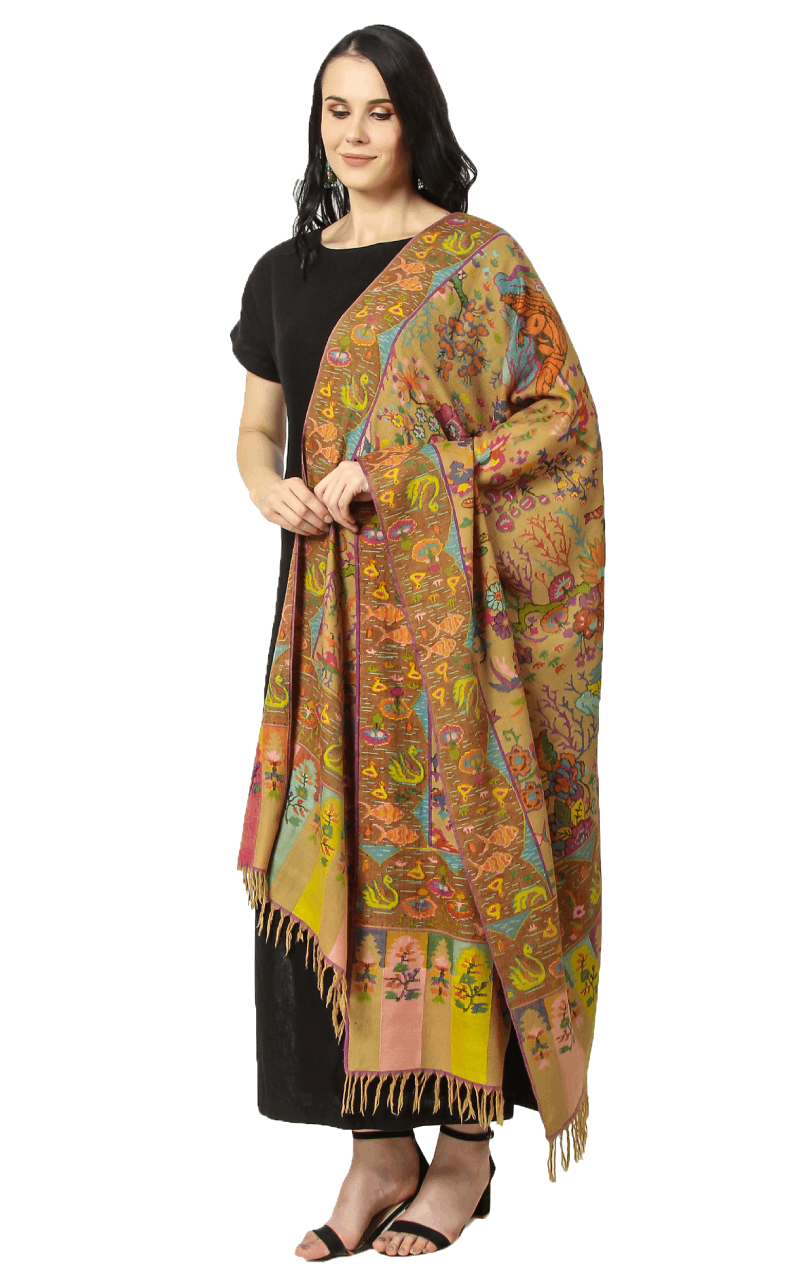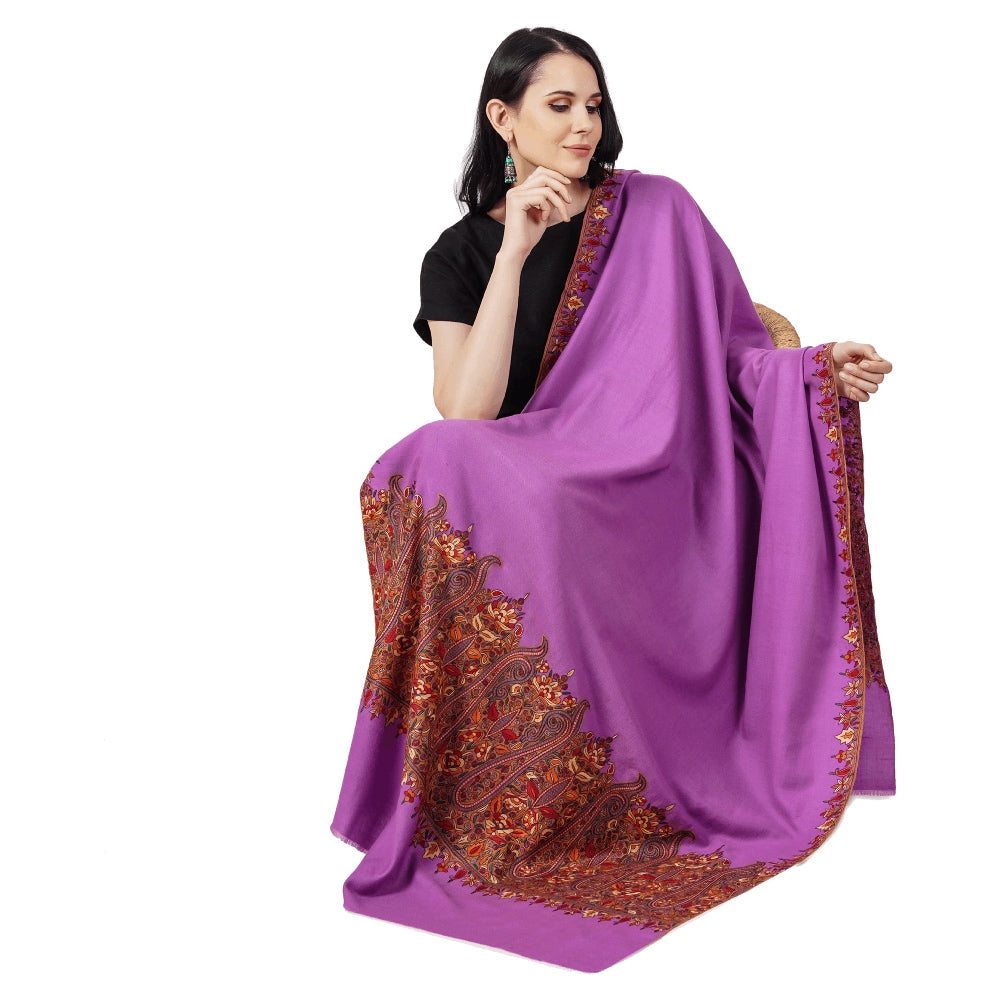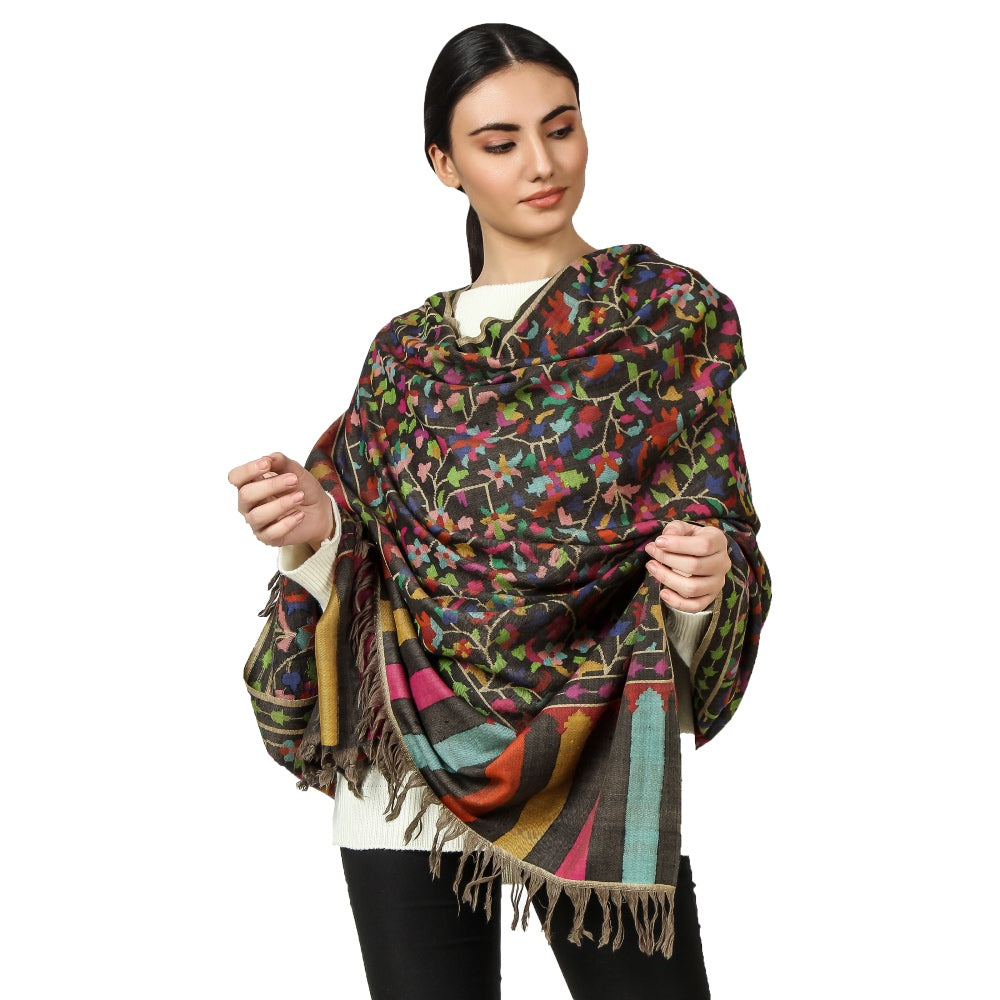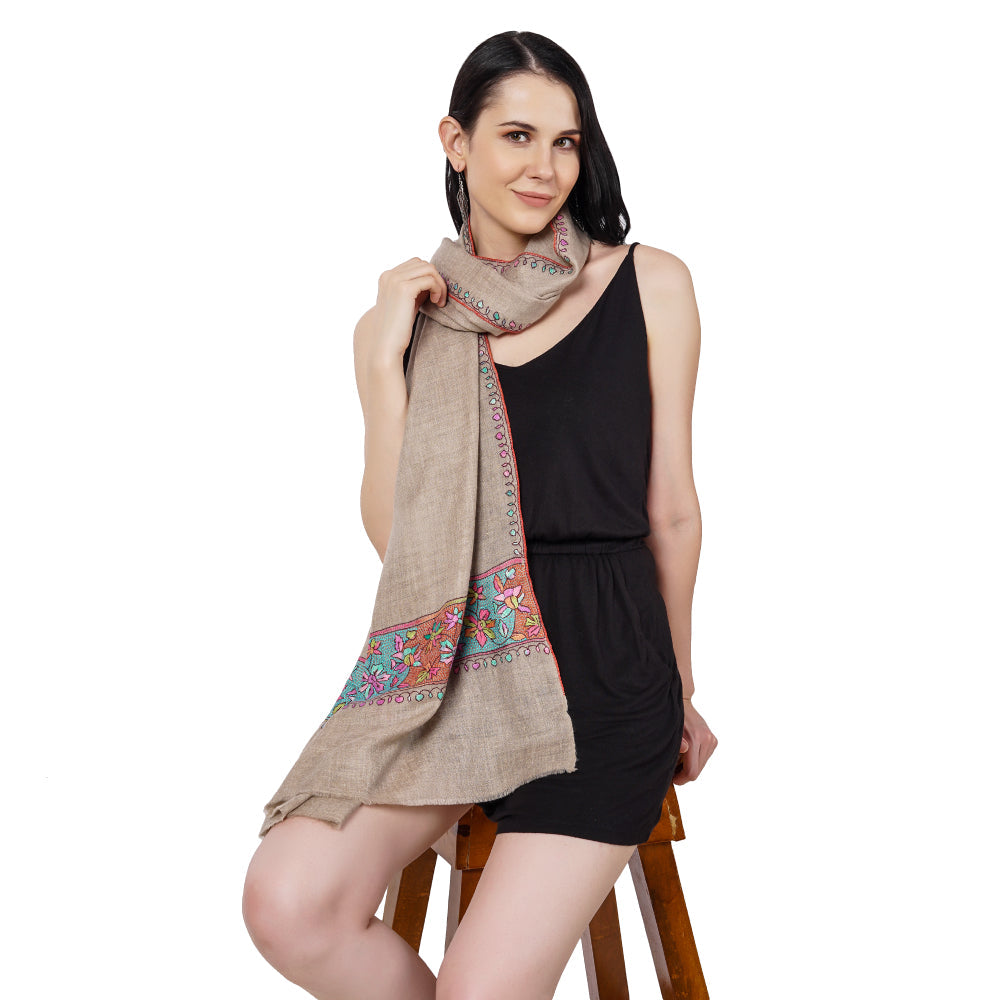
Wearing a masterpiece of Kani Pashmina
Share
Kani Pashmina is a luxurious type of shawl made from the finest wool of the Capra hircus goat, which is found in the Himalayan region of India. The wool is hand-spun and then woven on a traditional wooden loom, using a unique technique that involves using small bobbins or kanis to create intricate patterns. The shawls are known for their softness, warmth, and delicate designs, and are highly prized for their beauty and rarity.

Importance of wearing a masterpiece of Kani Pashmina
Wearing a masterpiece of Kani Pashmina is a symbol of luxury, elegance, and sophistication. These shawls are not only beautiful, but also incredibly versatile, making them perfect for any occasion, from formal events to casual outings. They are a timeless accessory that can be passed down from generation to generation, and are considered to be a valuable investment for any wardrobe.
The purpose of this article is to provide readers with a comprehensive understanding of Kani Pashmina, including its history, production process, and ethical concerns. We will explore the significance of wearing a masterpiece of Kani Pashmina, as well as the different styles and designs that are available. We will also discuss the proper care and maintenance of Kani Pashmina shawls, and highlight the steps being taken to address ethical concerns in the industry.
History of Kani Pashmina
Origin of Kani Pashmina
Kani Pashmina has a rich history that dates back to the Mughal era in India. It is said that the Mughal Emperor Akbar was a great admirer of the exquisite shawls made in Kashmir, which were known for their softness and intricate designs. The craft of weaving Kani Pashmina was brought to Kashmir by Persian weavers in the 15th century, and it soon became a popular trade in the region.
Traditional techniques used to create Kani Pashmina

The production of Kani Pashmina shawls is a highly skilled and time-consuming process that involves the use of traditional techniques that have been passed down through generations. The wool used in making Kani Pashmina shawls is sourced from the underbelly of the Capra hircus goat, which is known for its soft, fine hair. The wool is then hand-spun and dyed using natural dyes made from plants and minerals.
The weaving process involves using a wooden loom and small bobbins, known as kanis, to create intricate patterns and designs. The weavers use a special technique called 'kani weaving,' which involves weaving each thread separately, one at a time. This requires great skill and patience, and can take several months to complete a single shawl.
Historical significance of Kani Pashmina
Kani Pashmina shawls have played an important role in the history and culture of Kashmir. They were highly prized by the Mughal emperors, who considered them to be a symbol of wealth and status. The shawls were also given as gifts to foreign dignitaries and were used as a form of currency in trade.
Kani Pashmina shawls were also worn by the common people of Kashmir, and were considered to be a valuable family heirloom. They were often passed down from generation to generation, and were used to mark important milestones in a person's life, such as weddings and other celebrations.
Today, Kani Pashmina shawls continue to be highly valued for their beauty and craftsmanship, and are a testament to the rich cultural heritage of Kashmir.
Also read: The Beauty and Craftsmanship of Kani Pashmina: A Masterpiece of Weaving
The Making of a Kani Pashmina Shawl
Materials used in creating a Kani Pashmina Shawl

The materials used in creating a Kani Pashmina shawl are of the highest quality. The wool used is sourced from the underbelly of the Capra hircus goat, which is known for its fine and soft hair. The wool is then hand-spun into yarn, which is dyed using natural dyes made from plants and minerals. The use of natural dyes is an important aspect of creating Kani Pashmina shawls, as it ensures that the shawls are eco-friendly and safe for the skin.
Step-by-step process of creating a Kani Pashmina Shawl
The process of creating a Kani Pashmina shawl is a highly intricate and time-consuming process, and requires great skill and patience.
Step 1: Preparing the yarn - The hand-spun yarn is washed, dyed and dried in the sun. It is then rolled into balls for use in the weaving process.
Step 2: Designing the pattern - The weaver creates a design for the shawl, which is then drawn onto graph paper.
Step 3: Setting up the loom - The loom is set up with the warp threads, which are tied onto the loom frame. The weaver then sets up the pattern and begins to weave.
Step 4: Weaving the shawl - The weaver uses the small bobbins, known as kanis, to weave each individual thread separately, one at a time. This creates the intricate pattern and design of the shawl.
Step 5: Finishing the shawl - Once the shawl is completed, it is washed in cold water and then stretched out to dry. It is then ironed and the edges are finished with a hand-stitched border.
Time and effort required to create a Kani Pashmina Shawl
Creating a Kani Pashmina shawl is a labor-intensive process that can take anywhere from 6 to 18 months to complete, depending on the complexity of the design. The weaver must have a great deal of skill and patience to create the intricate patterns and designs, and must work diligently to ensure that each thread is woven perfectly. The end result is a beautiful and luxurious shawl that is truly a work of art.
Kani Pashmina as a Fashion Statement
Design and color variations of Kani Pashmina Shawls
Kani Pashmina shawls come in a variety of designs and color variations. Traditional designs include paisleys, flowers, and leaves, while more contemporary designs may feature geometric shapes or abstract patterns. The color palette is also diverse, ranging from muted earth tones to bright and bold colors. The versatility of Kani Pashmina shawls makes them a popular choice for both casual and formal occasions.
Styling Kani Pashmina Shawls for different occasions
Kani Pashmina shawls can be styled in a variety of ways to suit different occasions. For a casual daytime look, a Kani Pashmina shawl can be paired with jeans and a simple top, adding an elegant touch to an otherwise casual outfit. For a formal occasion, a Kani Pashmina shawl can be draped over a dress or suit, adding warmth and sophistication to the outfit. Kani Pashmina shawls can also be worn as a scarf, draped over the shoulders or wrapped around the neck for added warmth and style.
Celebrities who have donned Kani Pashmina Shawls
Kani Pashmina shawls are a favorite among celebrities and fashion icons. Kate Middleton, the Duchess of Cambridge, is known to have a collection of Kani Pashmina shawls, which she often wears to formal events. Oprah Winfrey and Amal Clooney have also been spotted wearing Kani Pashmina shawls, adding a touch of elegance to their outfits. Kani Pashmina shawls have also been featured on the runways of top fashion designers, such as Alexander McQueen and Chanel. Their popularity among celebrities and in high fashion is a testament to the timeless beauty and luxury of Kani Pashmina shawls.
Care and Maintenance of Kani Pashmina Shawls
Precautions to be taken while wearing Kani Pashmina Shawls
Kani Pashmina shawls are delicate and require special care while wearing them. Avoid wearing heavy or sharp jewelry that can snag or pull the delicate fibers of the shawl. Be cautious while sitting or standing near rough surfaces or sharp edges to prevent accidental damage. Avoid exposing the shawl to perfume or other chemicals that may damage the fabric.
Cleaning and storing Kani Pashmina Shawls
Kani Pashmina shawls should be dry-cleaned only, as washing or soaking the shawl may damage the delicate fibers. Store the shawl in a clean and dry place, away from direct sunlight, moisture, and dust. To prevent any creases, store the shawl in a horizontal position, folded gently, with tissue paper or a soft cloth in between the folds. Refrain from hanging the shawl, as it may lead to stretching and distortion of the fabric.
Avoiding common mistakes while handling Kani Pashmina Shawls
Some common mistakes that should be avoided while handling Kani Pashmina shawls include rough handling or pulling the shawl, exposing the shawl to direct heat, and storing the shawl in plastic bags. Avoid using harsh detergents or fabric softeners, as they may damage the delicate fibers of the shawl. Handle the shawl with clean and dry hands to prevent the transfer of oil or dirt to the fabric.
In conclusion, Kani Pashmina shawls are a luxurious and timeless addition to any wardrobe. However, they require special care and maintenance to preserve their beauty and longevity. By following the proper care and handling instructions, a Kani Pashmina shawl can be passed down as a treasured heirloom for generations to come.
Ethical Concerns Regarding Kani Pashmina
Kani Pashmina is a luxurious fabric that is highly sought after for its quality and craftsmanship. However, there are ethical concerns surrounding the production of Kani Pashmina that must be addressed. This section will discuss some of these concerns and the steps that are being taken to address them.
The issue of child labor in the Kani Pashmina industry
One of the biggest ethical concerns in the Kani Pashmina industry is the use of child labor. Children are often employed in the weaving of Kani Pashmina shawls, and they work long hours in dangerous conditions for very little pay. This is a violation of their human rights and is unacceptable.
Many organizations and companies are working to address this issue. They are working with local communities and government agencies to raise awareness about the issue and to provide education and support to families. They are also working to promote fair labor practices and to ensure that Kani Pashmina shawls are produced ethically and without the use of child labor.
Sustainable practices in Kani Pashmina production
Another ethical concern in the Kani Pashmina industry is the impact on the environment. The production of Kani Pashmina shawls requires a lot of water, energy, and resources, and this can have a negative impact on the environment.
To address this concern, many companies and organizations are working to promote sustainable practices in Kani Pashmina production. They are using eco-friendly dyes, reducing water usage, and promoting the use of renewable energy sources. They are also working to promote the use of sustainable fibers and to reduce waste in the production process.
Steps taken by government and organizations to address ethical concerns
The government and many organizations are taking steps to address the ethical concerns in the Kani Pashmina industry. The government has implemented laws and regulations to protect workers' rights and to prevent the use of child labor in the industry. Many organizations are also working to promote ethical practices and to raise awareness about the issue.
Organizations such as the Sustainable Fibre Alliance and the Better Cotton Initiative are working to promote sustainable and ethical practices in the production of Kani Pashmina shawls. They are working with local communities and companies to promote fair labor practices, to reduce the environmental impact of production, and to improve the livelihoods of workers.
In conclusion, there are many ethical concerns surrounding the production of Kani Pashmina shawls, including the use of child labor and the impact on the environment. However, many organizations and companies are working to address these concerns and to promote ethical and sustainable practices in the industry. By supporting companies and organizations that are committed to ethical practices, consumers can help to promote positive change in the Kani Pashmina industry.
Conclusion
Kani Pashmina is a beautiful and luxurious fabric that has a long and rich history. It is highly valued for its quality and craftsmanship, and it has become a symbol of luxury and status.
In this article, we have discussed the history of Kani Pashmina, the traditional techniques used to create it, and the time and effort required to make a Kani Pashmina shawl. We have also discussed how Kani Pashmina can be worn as a fashion statement, and we have provided tips on how to care for and maintain Kani Pashmina shawls.
However, we must also acknowledge the ethical concerns surrounding the production of Kani Pashmina. The use of child labor and the impact on the environment are serious issues that must be addressed. We have discussed the steps being taken by organizations and companies to promote ethical and sustainable practices in the Kani Pashmina industry, and we encourage consumers to support these efforts.
In conclusion, Kani Pashmina is a true masterpiece that represents the rich cultural heritage of India. By wearing a Kani Pashmina shawl, you are not only making a fashion statement but also supporting the craftsmanship and traditions of the weavers. We urge you to support ethical and sustainable practices in the Kani Pashmina industry, so that we can ensure that this beautiful fabric continues to be produced in a way that is fair and sustainable for everyone involved.






